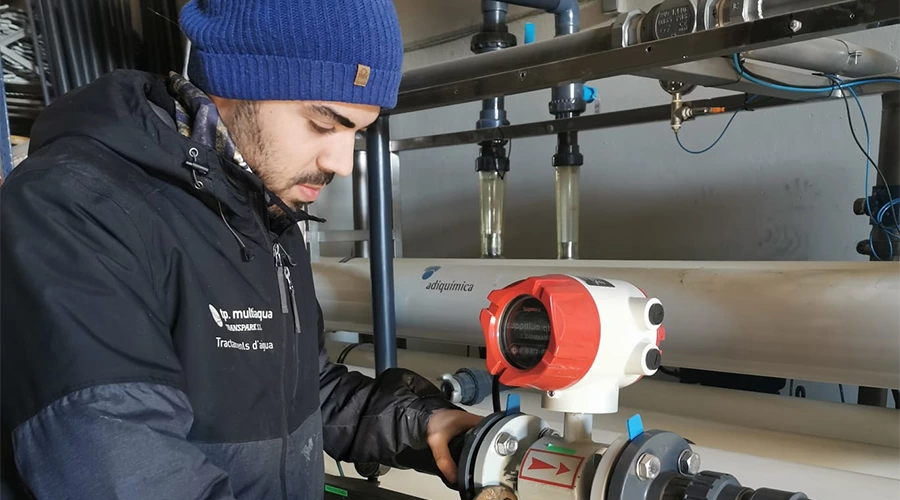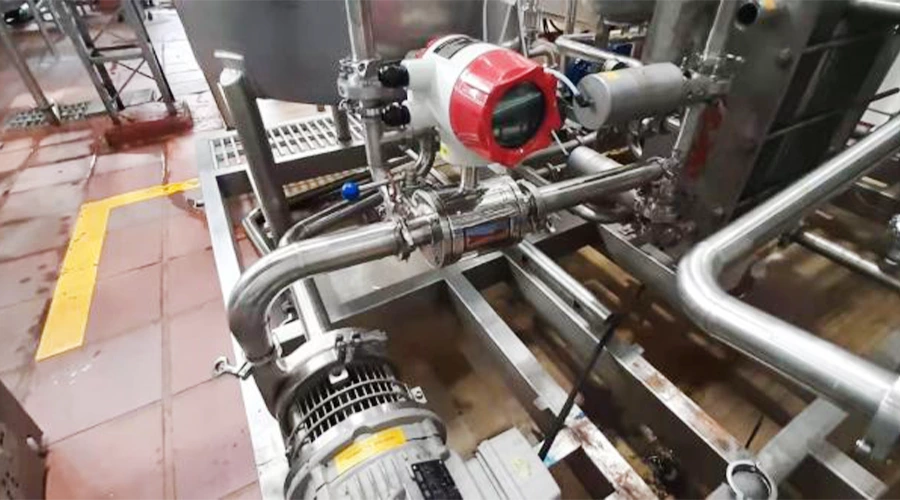Piping Requirements For Flow Meter Installation
Flow meter installation requires proper piping to ensure accurate and reliable measurement. The following are some of the piping requirements for flow meter installation:
Straight pipe run: The flow meter should be installed with a sufficient length of straight pipe before and after it. The upstream piping should have a minimum of 10 pipe diameters, while the downstream piping should have a minimum of 5 pipe diameters. This helps to stabilize the flow profile and reduce turbulence.
Pipe material and size: The piping material and size should be compatible with the flow meter and the fluid being measured. The pipe size should be chosen based on the maximum flow rate and the minimum flow rate expected. The piping should be free from any obstructions, such as valves, elbows, or reducers.
Orientation: The flow meter should be installed in the correct orientation, as specified by the manufacturer. This helps to ensure that the flow meter operates correctly and provides accurate readings.
Alignment: The flow meter should be installed in a way that ensures proper alignment with the piping. This helps to prevent any distortion or misalignment that could affect the accuracy of the readings.
Pressure and temperature: The piping should be designed to handle the maximum pressure and temperature expected. The flow meter should be installed in a location where the pressure and temperature are within the specified range for the flow meter.
Grounding: The piping should be properly grounded to prevent static electricity buildup, which can affect the accuracy of the flow meter.
Access and maintenance: The piping should be designed to allow easy access for maintenance and cleaning of the flow meter.
By following these piping requirements, the flow meter installation can provide accurate and reliable measurements, leading to better control and optimization of the process being measured.
What are the factors to be considered in piping arrangement for flow meter?
When arranging piping for flow meter installation, there are several factors that need to be considered to ensure accurate and reliable measurement. Some of these factors include:
Pipe size: The size of the pipe should be selected based on the maximum flow rate and minimum flow rate expected. Oversized pipes can cause measurement errors due to low flow velocities, while undersized pipes can cause high velocities that can lead to erosion and pressure drop.
Flow profile: The flow profile should be considered when designing the piping arrangement. Turbulent flow can cause measurement errors, and the flow should be stabilized before it reaches the flow meter.
Flow straighteners or flow conditioners may be required to ensure a stable flow profile.
Pipe length: Sufficient straight pipe lengths should be provided before and after the flow meter to ensure a uniform flow profile. The length of the straight pipe required is dependent on the flow meter type and should be determined based on the manufacturer's recommendations.
Piping orientation: The flow meter should be installed in the correct orientation as recommended by the manufacturer. This is necessary to ensure that the flow meter operates correctly and provides accurate readings.
Piping material: The piping material should be compatible with the fluid being measured and the flow meter. The material should be able to withstand the fluid's temperature and pressure, and should not corrode or contaminate the fluid.
Pressure and temperature: The piping arrangement should be designed to handle the maximum pressure and temperature expected in the system. The flow meter should be installed in a location where the pressure and temperature are within the specified range for the flow meter.
Maintenance access: The piping arrangement should allow easy access for maintenance and cleaning of the flow meter. The installation should consider the location of isolation valves, drain valves, and other components required for maintenance and servicing.
By considering these factors, the piping arrangement can be optimized to ensure accurate and reliable flow meter measurement.

What diameter pipe for flow meter installation?
The diameter of the pipe for flow meter installation depends on the maximum flow rate and minimum flow rate expected in the system. The pipe size should be selected based on the maximum flow rate, and the minimum flow rate should be considered to ensure that the flow meter can measure accurately at low flow rates.
For example, if the maximum flow rate in the system is 1000 liters per minute, and the minimum flow rate expected is 50 liters per minute, a pipe size of 2 inches (50 mm) might be suitable. However, the pipe size selection may also depend on other factors such as pressure drop, fluid viscosity, and pipe material.
It's important to consult with the flow meter manufacturer or an experienced engineer to determine the appropriate pipe size for your specific application. The manufacturer or engineer can also provide recommendations for flow straighteners or flow conditioners if necessary, to ensure a stable flow profile for accurate measurement.
What is the correct installation of flow meter?
The correct installation of a flow meter is crucial to ensure accurate and reliable measurement. Here are some general steps for installing a flow meter:
Select the correct location: The flow meter should be installed in a location where the flow is fully developed and free from turbulence. The location should also be easily accessible for maintenance and repair.
Prepare the pipe: The pipe should be prepared by removing any debris or foreign objects that may interfere with the flow meter's performance. The pipe should also be free of any obstructions, such as valves or elbows, that may cause turbulence.
Install the flow meter: The flow meter should be installed according to the manufacturer's instructions, including the correct orientation and alignment. If required, any necessary adapters or fittings should be installed to connect the flow meter to the pipe.
Connect the electrical connections: If the flow meter is electronic, the electrical connections should be made according to the manufacturer's instructions. Any necessary wiring should be properly grounded.
Test the flow meter: The flow meter should be tested to ensure that it is functioning correctly. This may involve testing the output signal, verifying the calibration, or checking for any leaks or malfunctions.
Perform maintenance and calibration: The flow meter should be regularly maintained and calibrated according to the manufacturer's recommendations. This may involve cleaning the sensor, replacing any worn parts, or adjusting the calibration.
It's important to follow the manufacturer's instructions and consult with an experienced engineer to ensure that the flow meter is installed correctly for your specific application. The proper installation and maintenance of a flow meter can help ensure accurate and reliable measurement over the lifetime of the device. Then moving here to learn more about specific flow meter installation guidelines, such as mechanical flow meter installation guidelines, venturi flow meter installation requirements, magnetic flow meter installation guidelines and so forth.

Flow meter installation rule of thumb
While the specific installation requirements for a flow meter may vary depending on the type of meter and the application, there are some general rules of thumb that can be followed for a successful installation:
Upstream and downstream straight pipe requirements: In general, the flow meter should be installed with a certain length of straight pipe upstream and downstream to ensure a stable and fully-developed flow profile. A commonly used rule of thumb is to have at least 10 pipe diameters of straight pipe upstream and 5 pipe diameters downstream of the meter.
Avoid turbulence and obstructions: The flow meter should be installed in a location where the flow is free from turbulence and obstructions. This may require avoiding locations near valves, elbows, or other pipe fittings that can cause turbulence in the flow.
Correct orientation: The flow meter should be installed in the correct orientation as specified by the manufacturer. This may involve ensuring that the meter is installed horizontally, vertically, or at a specific angle.
Adequate support: The flow meter should be supported adequately to prevent stress on the meter or the pipe, which can cause inaccuracies in the measurement.
Proper electrical and signal wiring: If the flow meter is electronic, the wiring should be properly installed and grounded to prevent interference or noise in the signal.
Regular maintenance: The flow meter should be regularly maintained and calibrated according to the manufacturer's recommendations to ensure accurate and reliable measurement over time.
These rules of thumb can serve as a general guide for installing flow meters. However, it's important to always refer to the manufacturer's specific installation requirements and consult with an experienced engineer to ensure the meter is installed correctly for your specific application.
Flow meter installation guidelines
Flow meter installation guidelines can vary depending on the type of flow meter and the application, but here are some general guidelines to follow:
Select the appropriate flow meter: The first step in flow meter installation is selecting the appropriate flow meter for the application. Consider factors such as flow rate range, viscosity, temperature, and fluid type.
Position the meter correctly: The flow meter should be positioned correctly in the pipeline to obtain accurate measurements. It is recommended to place the flow meter in a location with a fully developed flow profile, downstream of any obstructions or bends, and with enough straight pipe runs upstream and downstream to ensure a stable flow.
Install isolation valves: Install isolation valves upstream and downstream of the flow meter to allow for maintenance and calibration.
Ensure proper grounding: Proper grounding of the flow meter is important to prevent electrical interference and to ensure accurate measurements.
Use appropriate fittings and materials: Use appropriate fittings and materials that are compatible with the fluid being measured and the operating conditions.
Follow manufacturer's instructions: Follow the manufacturer's instructions for installation and calibration of the flow meter. This may include specific requirements for mounting, wiring, and calibration.
Perform regular maintenance: Regular maintenance and calibration of the flow meter is important to ensure accurate and reliable measurements. Follow the manufacturer's recommended maintenance schedule and perform regular checks of the meter's performance.
These guidelines can serve as a starting point for flow meter installation. However, it is important to always refer to the manufacturer's specific guidelines and consult with an experienced engineer to ensure proper installation and operation of the flow meter.
Flow meter installation distance
The distance required for flow meter installation depends on several factors such as the type of flow meter, pipe diameter, and flow rate. Here are some general guidelines:
Upstream distance: The upstream distance for flow meters typically ranges from 5 to 10 pipe diameters. However, for some types of flow meters such as the Venturi meter or the electromagnetic flow meter, the required upstream distance may be longer. This is to ensure that the flow is fully developed and free from any disturbances that could affect the accuracy of the measurements.
Downstream distance: The downstream distance for flow meters typically ranges from 2 to 5 pipe diameters. This is to ensure that the flow has fully recovered from the pressure drop caused by the meter and that the flow is fully developed downstream of the meter.
Straight pipe runs: In addition to the upstream and downstream distances, it is also important to have sufficient straight pipe runs before and after the flow meter. This is to ensure that the flow is fully developed and free from any turbulence or swirls that could affect the accuracy of the measurements.
Specific manufacturer recommendations: It is important to consult the manufacturer's specific installation guidelines for the flow meter being used. They may have specific recommendations for the required distances based on the type of meter, pipe size, and flow rate.
In summary, the distance required for flow meter installation will depend on several factors and it is important to consult the manufacturer's guidelines and work with an experienced engineer to determine the appropriate installation distance for your specific application.











